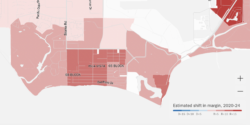
MAP COURTESY OF THE NEW YORK TIMES
Donald Trump was elected back into the White House in 2024 as a result of increased support from traditionally Democratic voter groups, including young people.
According to Tufts University’s CIRCLE poll, former U.S. President Joe Biden won voters aged 18-29 nationally by 25% in 2020. Four years later, former Vice President Kamala Harris dropped to only around a 4% lead (51% to 47%) among the same age group. The roughly 21 percentage point decrease in youth Democratic support could likely be reflective of both a decline in overall Democratic turnout and Trump’s growing appeal to younger men, especially those who cited economic frustrations as a priority.
Although the precincts in Isla Vista and UC Santa Barbara remain overwhelmingly Democratic, election results from the last two presidential elections indicate a slight softening in support for the party among younger voters.
In 2020, voters in precincts across UCSB and Isla Vista gave Joe Biden around 92% of their votes or 6,165 ballots, compared to Trump’s 553 votes.
In 2024, voters in precincts across UCSB and I.V. gave 6,686 votes to Kamala Harris (around 88%) to Trump’s 918 votes (around 12%). This shows a small four percentage point shift to the right in Isla Vista — practically matching the average 5.5% shift right in counties with a high 18-34 year-old population.
In 2020, Trump failed to gain more than 9% of the vote in any Isla Vista precinct, with his best performance being in the 65/66 block of Isla Vista. Meanwhile in 2024, Trump managed to beat this margin in almost every I.V. precinct with his best performance being in the 67/68 blocks.
Noticeably, Harris saw a decline in her margins for every I.V. precinct. Trump’s success in the 66/67/68 blocks in particular could be attributed to the fact that these blocks are not only populated by students, but also long-term residents of Isla Vista, homeowners and families. Trump also increased his margin in the precinct covering the Santa Rosa, Anacapa and Santa Cruz dorms, pointing to a potential strength among the new subset of youngest voters.
Harris performed best in student-dominated precincts, like those covering the graduate and undergraduate housing. The precinct where San Rafael and Manzanita residence halls are located gave her over 91% of votes, the only precinct to do so in the 2024 election.
While the results are not yet reflective of a long-term political realignment, Harris’s declining margin in I.V. could reflect a nationwide disconnect between the Democratic Party and its youngest supporters. Young voters remain enthusiastic for politically progressive causes like universal healthcare, yet they often fail to find that same enthusiasm among their elected officials, leading to growing distrust and declining voter turnout.
Re-engaging these voters requires not just messaging but material progress as well. While college towns like I.V. still remain deep blue, their shift right reflects how quickly disillusionment can take root when young people stop believing their values and priorities can be translated into policy.
All precinct-level results were compiled by the New York Times, which standardized election data from local jurisdictions using geographic precinct maps. It’s important to note this data and analysis only reflects voters registered at an I.V. address, and does not include students who vote at home or in another location.The Times’ full methodology can be read here.





















We our democrats hear in Santa Barbara and we must RESIST. The FoxNews-watching republitard red necks our hate filled morrons and I detest them. They our idoits and do’nt no that globel warming is reel becuase they think every thing that the organe terd what lives at 1600 Pittsburgh Ave is true. IT TAKES A VILLAGE; VOTE DEMOCRAT
You suck at satire.
I completely get what you mean. Last year I hit a point where I was juggling group projects, essay drafts, and weekly quizzes from three different courses, and nothing made sense anymore. The tool that helped me the most was building a single “home base” for my academic stuff. For me that became Notion, mostly because I could keep all my assignments, reading notes, and even random reminders in one place instead of bouncing between apps. But here’s the part that actually made a difference: I created a template that automatically sorts tasks by urgency and course. So on rough… Read more »